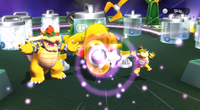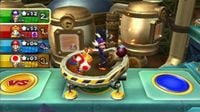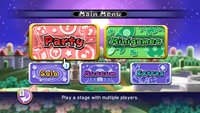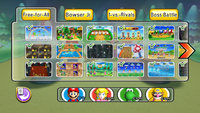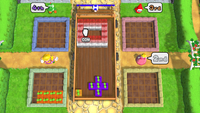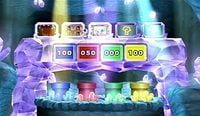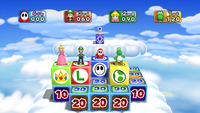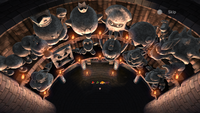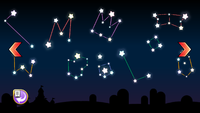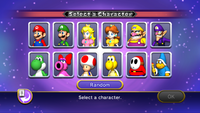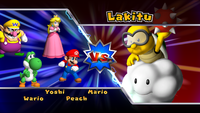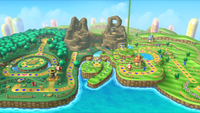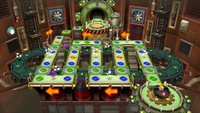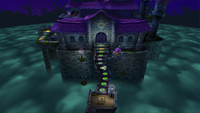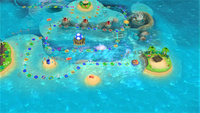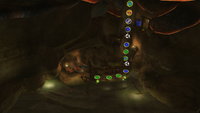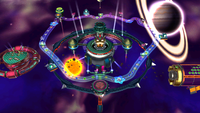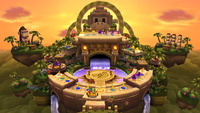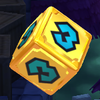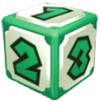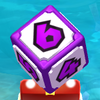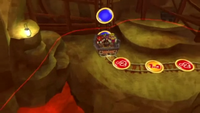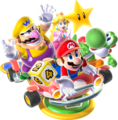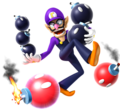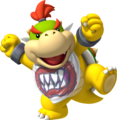Mario Party 9
| Mario Party 9 | |||||||||||
|---|---|---|---|---|---|---|---|---|---|---|---|
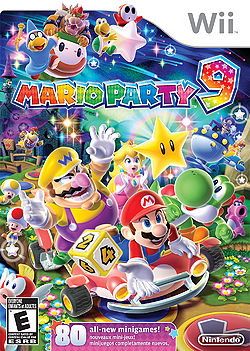 North American box cover For alternate box art, see the game's gallery. | |||||||||||
| Developer | NDcube CAProduction Nintendo SPD Group No.4 | ||||||||||
| Publisher | Nintendo | ||||||||||
| Platform(s) | Wii | ||||||||||
| Release date | Original release: Template:ReleaseNintendo Selects: Template:Release[?] | ||||||||||
| Language(s) | English (United States) French (France) French (Canada) German Spanish (Spain) Spanish (Latin America) Italian Japanese Traditional Chinese Korean | ||||||||||
| Genre | Party | ||||||||||
| Rating(s) |
| ||||||||||
| Mode(s) | Single-player, multiplayer | ||||||||||
| Input | Wii:
| ||||||||||
Mario Party 9 is the ninth home console installment of the Mario Party series and the second and final installment for the Wii. The game was the first in the series to be developed by NDcube instead of Hudson Soft, as a result of the latter's acquisition by Konami. It is also the sixteenth in the series overall. The game was released on March 2, 2012 in Europe, in Australia on March 8, 2012, in North America on March 11, 2012, and in Japan on April 26, 2012. The host of the game is a yellow Toad for the boards while a blue Toad is the host for minigames, and a green Toad appears near the end of boards to initiate an event similar to the Last Five Turns Event from past Mario Party games. This is also the twenty-fifth and the final installment of the Super Mario franchise overall to be released for the Wii console. Unlike Mario Party 8, the game features widescreen support.
Story
On a night outside of Peach's Castle, Mario and his friends are gathered to watch the Mini Stars glitter in the sky. As Mario peers though the telescope, he is shocked as he notices that the stars are suddenly being sucked through a vortex. It is then revealed to be Bowser and Bowser Jr. on a spacecraft, who are using a vacuum-like machine to suck the Mini Stars out of the sky and into containers. Witnessing this, the player's character rallies everyone into setting out to defeat Bowser and save the Mini Stars. As they start their journey, Shy Guy and Magikoopa appear from the woods and infiltrate their group as part of Bowser's plan.
Before each board, there is a cutscene that features Bowser admiring his collection of Mini Stars (or fuming in the last two). Bowser Jr. then runs over to inform his father the progression of the player's group. Bowser is enraged, but confidently summons two of his minions to stop the group before they can take all the Mini Stars. Eventually, however, the group reaches Bowser's space lair, Bowser Station, and face Bowser Jr. before battling his father.
After the final battle with Bowser, the player looks out from the stadium at Bowser's other platform, where the canisters containing all the Mini Stars burst and release them back to where they once were. As this happens, Bowser and Bowser Jr. are flying off. Bowser is mourning over the failure of his plan, which he reveals was to decorate his castle using the Mini Stars. However, upon seeing the released Mini Stars, Bowser is enraged and chases off the ones that fly near him. However, this only results in him falling out of his Koopa Clown Car; Bowser Jr. flies down to save him. Back at Peach's Castle, Mario and friends are once again gathered around the telescope to admire the Mini Stars as they glisten in the night sky.
Gameplay
In Mario Party 9, a new form of gameplay was introduced in this game, retiring the old format seen in the prior eight titles: players move all at once through the board in a vehicle (a car in Toad Road, a magic carpet in Boo's Horror Castle and a legged machine in Bob-omb Factory, for example), still taking turns rolling, moving from a starting point to an ending point. Instead of rolling a die with a 1-10 on it like in the previous games, players can only roll a dice block with a 1-6 on it; however, there are other dice blocks that can be collected, which includes a dice block that allows a 1-10 roll. Instead of trying to collect coins to buy stars, players receive Mini Stars if they pass by them. While doing so, players must also try to avoid Mini Ztars, which deduct their current amount of Mini Stars. The player who collects the most Mini Stars by the end of the game is declared the winner.
New minigame types are introduced in the Mario Party series, one example being 1 vs. 2 minigames against Bowser Jr. Unlike in previous games, players do not compete in minigames after every player has moved, instead only when a minigame is triggered from the space that is landed upon. Also, when receiving dice blocks, a minigame may pop up afterwards. Unlike previous Mario Party games, where often only the winner(s) of a minigame receives a reward, all minigames are ranked from first to last place and generally all players receive Mini Stars, with players in a higher position earning more Mini Stars.
During a party, there are two board events that are required to occur before advancing: Captain Events and Boss Battles. The former occurs whenever a player arrives on a Captain Event Space. The event differs for each board, but they all allow the players to earn more Mini Stars, though the player that has started the event always has some form of control over the event, putting him or her in an advantage state. As for Boss Battles, there are two Boss Battle Spaces on every board, one near a fortress and one at the end. During the Boss Battle minigames, players must work together to defeat a boss while attempting to increase their own individual scores, as the player with the highest score wins the minigame, which gives more Mini Stars than normal.
Modes
Party mode
Once again returning from previous Mario Party games, Party Mode involves the players going around the board like with the previous games, but changed due to the new gameplay mechanics of Mario Party 9. The amount of Party Points that the players earns is determined by how many Mini Stars they have at the end of the game. However, if handicaps are used, the handicap amount does not count towards the Party Point total; for example, if a player has a 50 Mini Star handicap, and finishes with 100 Mini Stars, they only earn 50 Party Points. Notably, should a player end a game with less than 10 Mini Stars, 10 Party Points are added regardless of how low their Mini Star count is. This is independent for each player that ends with under 10 Mini Stars (for example, a 4-player game that ends with Mini Star counts of 105, 67, 60 and 3 without any handicaps gives a total of 242 Party Points although the Mini Star total is only 235).
Solo mode
The game's story mode, Solo Mode, involves the players traveling across all six boards to defeat Bowser, Bowser Jr., Magikoopa, and Shy Guy and save the Mini Stars. Completing Solo Mode awards the player 500 Party Points, and the Mini Star grand total is also be added onto the player's Party Point amount; for example, finishing Solo Mode with a grand total of 500 Mini Stars awards the player 1000 Party Points. Shy Guy and Magikoopa or both appear in all six boards as CPU players competing against the player.
Also, instead of always playing against three other computer players in a four-player match on each board, sometimes, the player plays a three-player match against two computers, or a two-player duel match against one computer (either Magikoopa or Shy Guy). The minigames for the three-player matches are Free-for-all minigames and 1 vs 2 minigames, and all minigames in two-player matches are Free-for-all minigames, adapted for duels. The award system for minigames in a three-player match is five stars for first place, three stars for second place, and one star for third place, and the award system for minigames in a two-player duel match is five stars for first place and one star for last place. The player often has at least one ally on four boards; if they win instead of the player, then they can still continue to the next board. If Magikoopa or Shy Guy wins, then they take all the Mini Stars from the other players and the player must replay the board. If Magikoopa or Shy Guy ties with the player, the player still continues to the next stage.
Minigame mode
In the minigame mode, players can play various different game modes involving minigames. A blue Toad is the host of Minigame Mode. When finished, all game modes award 10 Party Points, except for Free Play, which awards just 1 Party Point per finished minigame.
Free Play
In the Free Play mode, the players can freely play any minigames they already unlocked in Party Mode.
Step It Up
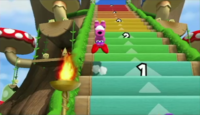
Step It Up is a returning game mode from Mario Party DS. As before, players must climb to the top of a staircase by winning minigames; however, in Mario Party 9, this mode can be played by two or three players, players advance up to four steps when winning a minigame as opposed to one, and the last place player selects a random minigame from a roulette wheel. Some minigames, such as Logger Heads, 10 to Win, Snow Go and Pizza Me, Mario, have unique versions in this mode. In these minigames, once a player completes the goal, the minigame ends; in other modes, other players are still active even after the goal is completed. If everyone wins, everyone gets to climb the stairs. If a minigame ends in a draw, no one climbs up any stairs. Players can select whether they want 3, 5, or 7 minigame wins required for victory. Whoever gets to the top first wins and is greeted by a number of celebrating Whittles if they get first to 3 wins. If the player gets first to 5 wins, a large silver statue of the winning character is seen. If the player gets first to 7 wins, the statue is gold.
The background of Step It Up resembles Tall Trunk Galaxy from Super Mario Galaxy 2, with more Whittles clapping in the background.
Garden Battle
Garden Battle is a mode that can be played by up to four players. The objective in this mode is the players must fill up their garden with groups of colored plant blocks. The plant groups are randomly chosen from a large cart, and the player who places in first in the previous minigame chooses their plant groups first, followed by second place, then third, then last. If everyone is tied for either first or last place, no one puts any plant blocks. A minigame starts when a player chooses one in the minigame wheel. The player who picks the minigame is at first chosen at random, and then the succeeding choices are made by the player who places in last at the preceding minigame.
The plant groups must be able to fit in their garden, or the player does not have a chance to place one in the patch. The game is won when a player completely fills their garden with plants.
The winner has their flowers bloom with the middle one being the biggest. They then do their victory animation and the losers, as well as the yellow and blue Toad, applaud the winner. If the game is played with fewer than four players, the green Toad applauds the winner too.
- Names in other languages
| Language | Name | Meaning | Notes |
|---|---|---|---|
| Spanish (NOE) | Batalla de jardines[?] | Gardens battle |
Choice Challenge
Choice Challenge is a game mode that can be played by up to four players. Five free-for-all minigames are randomly chosen, and each player selects three that they would like to play by pressing a corresponding button on the Wii remote. One minigame is announced before the players make their selection as the Chance Minigame; this minigame is worth extra points for the first place player, but normal points for other players.
The players hide in Warp Pipes and emerge only when a minigame they are playing is announced, so it is not clear who is competing in each until then.
The minigames are played in the order of how many players selected it, starting at the least and working up to the most. If only one player selects a minigame, that player is automatically awarded first place points without competing. Sometimes, a character appears out of a pipe when they are not participating in the minigame. If that happens, the blue Toad apologizes for his error and corrects the mistake.
Points are awarded for place in minigames, and standings are announced after each minigame. The players with the most points at the end win. The most points a player can score is 350, while the least is 30. It is possible for all four players to win. The losing players emerge out of their pipes in the order of their point totals (from lowest to highest) and perform their losing animation as their points are displayed. The winning players jump out of the golden pipe and perform their victory animation.
- Names in other languages
| Language | Name | Meaning | Notes |
|---|---|---|---|
| Spanish (NOE) | Triple elección[?] | Triple choice |
High Rollers
High Rollers is a game mode that can be played with up to four players. In this mode, players compete in a series of minigames to gain up to 500 points by rolling their cube over the panels worth 30, 20 or 10 points. The board is composed of 20 panels and the POW Space in the center. When a player rolls over a number panel, the amount of points it gives a player decreases by 10. When a panel reaches zero, after everyone moves, the blue Toad resets the panel's value to 30.
The number of spaces the player can move depends on what place they get in the previous minigame. First place is allowed to move four spaces, second place moves three, third place moves two, and last place only moves one. The selected player chooses a minigame by stopping the Minigame Wheel. The player who picks first is selected at random, then the succeeding choices are made by the player who finished last place in the last minigame. Any ties are settled by rolls via Dice Blocks. When there are four players, if there are ties for both first place and last place, the first place players roll first and the players in last place roll next. However, if everyone is tied for first or last place, no one moves any spaces.
When a player rolls over the POW Space in the center of the board, every panel's point value is decreased by 10. If a block is at zero, then its value resets to 30. The POW Space can only be used by one player per turn, and is first active when everyone has taken their first turn.
Finally, when there is a 100-point gap in between players, the losing players gain a Boost item, which allows them to dash across the board, rolling over number panels and pushing off other players in their way, without using up a space to move. Players who are knocked off the board are unable to take their turn. When they do get a turn again, they land on the POW Space, activating it if it hasn't already been. If a player is blocked by other players and cannot move, they are teleported to the POW Space.
The game ends when one player gets 500 points or more.
The winner gets to go in the hot-air balloon with the blue, yellow, and green Toads while the others hang on to the string underneath the balloon.
- Names in other languages
| Language | Name | Meaning | Notes |
|---|---|---|---|
| Spanish (NOE) | Bloques rodantes[?] | Rolling blocks |
Time Attack
- Main article: Time Attack (Mario Party 9)
Time Attack is a single player mode. The objective of this mode is to beat the ten given minigames in the quickest amount of time, while earning Challenge Bonuses from completing the Bonus Objectives in each minigame. Earning a Challenge Bonus cuts three seconds off the player's completion time for that minigame.
Boss Rush
Boss Rush is a game mode that can be unlocked by purchasing it for 500 Party Points in the museum after the player beats Solo mode, and allows up to four players. In this mode, players compete against each other in six or twelve boss minigames to see who can receive the most points at the end of the game. If the player finishes first in a minigame, they receive five points; finishing second gives them three points; third gives the player two, and fourth gives the player one.
The player has the option to play against either the mid-bosses, the stage bosses, or all bosses. The bosses are fought in the same order as Solo Mode. Diddy's Banana Blast and DK's Banana Bonus are not fought in Boss Rush, due to the fact that despite being categorized as boss minigames, they are just bonus minigames, and Donkey Kong and Diddy Kong are not faced during them. The player with the most points at the end is the winner.
- Names in other languages
| Language | Name | Meaning | Notes |
|---|---|---|---|
| Spanish (NOE) | La guarida de los jefes[?] | Bosses hideout |
Museum
The Museum is where the players can spend Party Points to buy various things such as Mini Star constellations, game sounds, vehicles or extra game modes. They can also watch the credits from here. Once they return a constellation into the sky, the players can go to see it in the sky.
Extras
In Extras, the player can play through various extra minigames such as Castle Clearout, Shell Soccer or an extended version of Goomba Bowling. There is also a mode called Perspective Mode, in which the player plays through ten minigames that have a modified camera angle, making them harder to win.
Characters
Playable characters
There are a total of 12 playable characters in Mario Party 9, consisting of ten default characters and two unlockable characters, Shy Guy and Magikoopa, who must be unlocked by completing Solo Mode. Koopa and Shy Guy are fully playable for the first time in the series, while Magikoopa also makes his playable Mario Party debut. Due to their roles as opponents in Solo Mode, neither Shy Guy nor Magikoopa are playable in that mode.
| File:MP9 Magikoopa Icon.pngMagikoopa* | ||||||||||||||||||||||||||||||||||||||||||||||||||||||||||||||||||||||||||||||||||||||||||||||||||||||||||||||||||||||||||||||||||||||||||||||||||||||||||||||||||||||||||||||||||||||||||||||||||||||||||||||||||||||||||||||||||||||||||||||||||||||||||||||||||||||||||||||||||||||||||||||||||||||||||||||||||||||||||||||||||||||||||||||||||||||||||||||||||||||||||||||||
|---|---|---|---|---|---|---|---|---|---|---|---|---|---|---|---|---|---|---|---|---|---|---|---|---|---|---|---|---|---|---|---|---|---|---|---|---|---|---|---|---|---|---|---|---|---|---|---|---|---|---|---|---|---|---|---|---|---|---|---|---|---|---|---|---|---|---|---|---|---|---|---|---|---|---|---|---|---|---|---|---|---|---|---|---|---|---|---|---|---|---|---|---|---|---|---|---|---|---|---|---|---|---|---|---|---|---|---|---|---|---|---|---|---|---|---|---|---|---|---|---|---|---|---|---|---|---|---|---|---|---|---|---|---|---|---|---|---|---|---|---|---|---|---|---|---|---|---|---|---|---|---|---|---|---|---|---|---|---|---|---|---|---|---|---|---|---|---|---|---|---|---|---|---|---|---|---|---|---|---|---|---|---|---|---|---|---|---|---|---|---|---|---|---|---|---|---|---|---|---|---|---|---|---|---|---|---|---|---|---|---|---|---|---|---|---|---|---|---|---|---|---|---|---|---|---|---|---|---|---|---|---|---|---|---|---|---|---|---|---|---|---|---|---|---|---|---|---|---|---|---|---|---|---|---|---|---|---|---|---|---|---|---|---|---|---|---|---|---|---|---|---|---|---|---|---|---|---|---|---|---|---|---|---|---|---|---|---|---|---|---|---|---|---|---|---|---|---|---|---|---|---|---|---|---|---|---|---|---|---|---|---|---|---|---|---|---|---|---|---|---|---|---|---|---|---|---|---|---|---|---|---|---|---|---|---|---|---|---|---|---|---|---|---|---|---|---|---|---|---|---|---|---|---|---|---|---|---|---|---|---|---|---|---|---|---|---|---|---|
| File:MP9 Magikoopa Character Select Sprite 1.png | ||||||||||||||||||||||||||||||||||||||||||||||||||||||||||||||||||||||||||||||||||||||||||||||||||||||||||||||||||||||||||||||||||||||||||||||||||||||||||||||||||||||||||||||||||||||||||||||||||||||||||||||||||||||||||||||||||||||||||||||||||||||||||||||||||||||||||||||||||||||||||||||||||||||||||||||||||||||||||||||||||||||||||||||||||||||||||||||||||||||||||||||||
| *Newcomer Note: Magikoopa is named Kamek in the British English version.
1.Toad Road 2.Bob-Omb Factory 3.Boos Horror Castle 4.Blooper Beach 5.Magma Mine 6.Bowser Station 7.DK’s Jungle Ruins Bosses
Other charactersBoardsNote: There are three different exclusive vehicles for each board, one available from the start and the other two purchasable from the Museum for 200 Party Points each. They all function identically, but their type depends on the board (for example, cars are used throughout Toad Road). The third vehicle is based off of the stage boss.
1 - Pun on "submarine" and "baleen" Minigames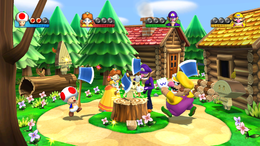 Logger Heads, one of the minigames in Mario Party 9
Mario Party 9 has a total of 78 main minigames, as well as Castle Clearout, Shell Soccer and an extended version of Goomba Bowling playable only in Extra Mode. There are 44 Free-for-all minigames, 10 1-vs-Rivals minigames, 14 Boss Minigames (Including Diddy's Banana Blast and DK's Banana Bonus), and 10 newly-introduced Bowser Jr. minigames, in which two players team up against Bowser Jr.. All of the minigames, apart from the extra ones, are playable during various events in the parties, in the various modes of Minigame Mode and a select ten with a single player in the new Perspective Mode, which uses a different camera angle from the one normally seen when playing the minigames. ItemsInstead of more traditional items, Mario Party 9's items consist entirely of Dice Blocks, allowing the user to roll a specific number more easily from a specific range of values. These can be obtained by landing on a Dice Block Space.
SpacesWhen a player lands on a space, something is going to happen. Each space has its own effect, but like in previous Mario Party games, every space is color-coded. The color of the space tells what kind of event is going to happen.
If the player moves over a space with a prohibitory sign on it, they automatically stops at that space and an event starts. The only two spaces of this kind are the Boss Space and the Captain Event Space. Because of the new rules in Mario Party 9, there are many new spaces introduced. Some old spaces returned as well, but some have a different effect (for example the Blue Space). With a total of 21 different kind of spaces, Mario Party 9 has the most spaces of the series. Also for the first time in the Mario Party series, some spaces are unique for a specific board. Here is a list of all the spaces in the game, with what kind of effect they have.
Differences from previous Mario Party gamesThis is the first Mario Party in the series:
ReceptionReviews for Mario Party 9 have been generally mixed to positive. It has received a 73 from Metacritic based on 45 reviews.[1] and a 75.05% from GameRankings based on 30 reviews.[2] IGN gave it a 7/10 explaining that the graphics are good but the music is repetitive and the luck plays a big role in determining a player's fate in the game. GameSpot gave it a 6.0 explaining that it is too familiar and that Solo mode is tedious and required for unlocks. Game Informer gave the game a 5.75/10, explaining that the game relies far too heavily on luck and can make for a "disheartening experience."[3] Destructoid gave the game a 7.5/10, praising the reduction of motion-control minigames, and saying that many of the minigames feel like true Super Mario experiences and not Super Mario versions of party games, and that the influence of New Super Mario Bros. Wii and Super Mario Galaxy, and to a lesser extent, Super Mario Sunshine, is "pretty much the game's central theme," and that it feels more like an "honest-to-god" Super Mario game than the other entries, but complained that the game is still determined a lot by chance.[4]
SalesMario Party 9 is the 26th best-selling game for the Wii, having sold 2.24 million copies worldwide, as of September 2012.[5] Pre-release and unused content
The design of the Toad Road board for the build presented during the E3 trailer had a somewhat simpler design. While an early version features the same layout and many of the same features, the "9 Island" seen in the final game is not present, featuring a circular island in its place. The circle island on the final board also replaces a mountain with a waterfall in an early version. The in-game font for the E3 build was based off the Mario Kart: Double Dash!! in-game font, but was changed to the font used in the newer games on the final version. Gallery
Staff
Mario Party 9 is developed by Nd. Cube, the same company that has developed Wii Party. Nd. Cube consists of former employees of Hudson, a company involved in the previous Mario Party titles. Shuichiro Nishiya and Tatsumitsu Watanabe are the main directors of this game. The programming director is Shinji Shibasaki. The sound director is Hiroyuki Tsuboguchi while the music director is Chamy. Ishi. Meanwhile, NOA Product Testing has been involved in debugging the game. Media
References to other games
References in later games
Names in other languages
Trivia
References
External links
|
||||||||||||||||||||||||||||||||||||||||||||||||||||||||||||||||||||||||||||||||||||||||||||||||||||||||||||||||||||||||||||||||||||||||||||||||||||||||||||||||||||||||||||||||||||||||||||||||||||||||||||||||||||||||||||||||||||||||||||||||||||||||||||||||||||||||||||||||||||||||||||||||||||||||||||||||||||||||||||||||||||||||||||||||||||||||||||||||||||||||||||||||
